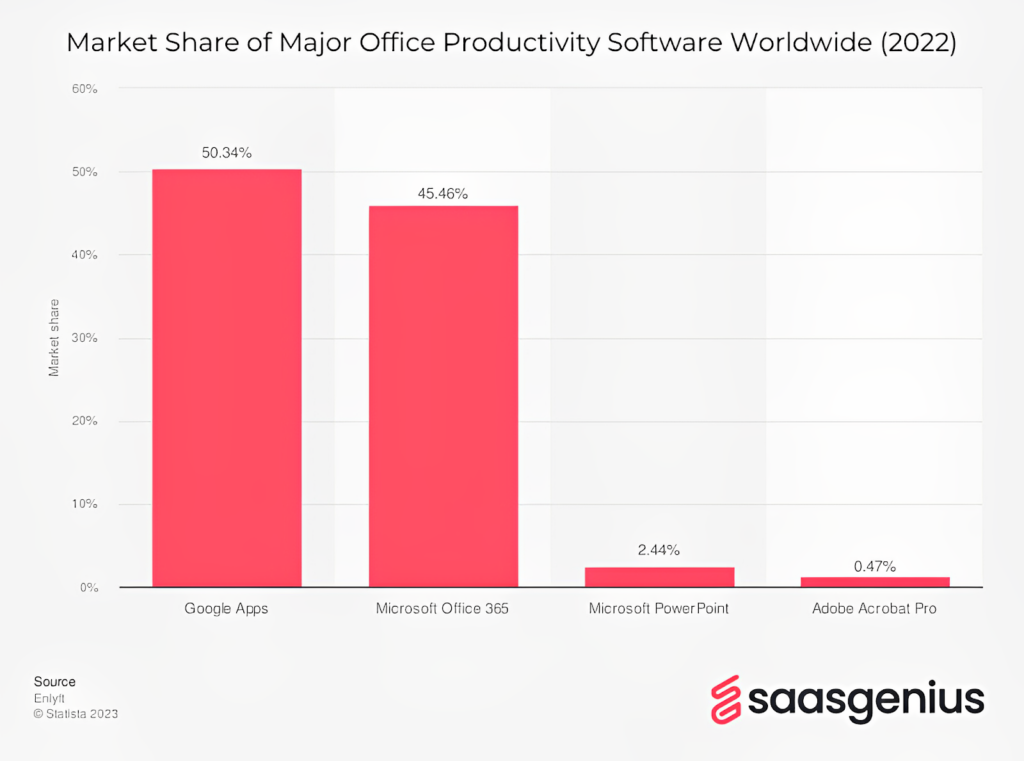Productivity Software
Productivity software is an application software designed to help entrepreneurs increase productivity and grow their businesses. It aids with tasks related to producing documents, spreadsheets, presentations, and it also helps businesses operate on computing devices. The software can be provided via a transactional license or as a subscription to stationary workplaces and cloud services.
The productivity software market as a whole is large and diverse, with numerous products and solutions available for various operating systems and devices (check out these 21 productivity tools for entrepreneurs). The most common environments for business productivity software use are the B2B and B2C markets.
The statistics provided by Statista portray the market share of the following productivity management software in 2022: Google Apps, Microsoft Office 365, Microsoft PowerPoint, and Adobe Acrobat Pro.
MORE: We compare Microsoft 365 and Google Workspace. Which is better in 2023?

Market Share Productivity Software Statistics
Let’s take a look at the statistics.
- As of 2022, over 50% of the market share for major office suite technologies worldwide is controlled by Google Apps.
- Following closely behind is Microsoft 365, with over 45% of the market share.
- Microsoft PowerPoint and Adobe Acrobat Pro control a minor part of the productivity management software market share. They own roughly only 3%.
What else do we know about the productivity software sector?
The Productivity Software sector has experienced consistent growth in recent years, largely driven by the development of faster and more efficient software programs and tools by different software providers.
The use of smartphones and applications has also contributed to productivity growth. Companies increasingly recognize the value of providing employees with effective productivity tools to improve retention rates.
During the pandemic, collaboration software gained significant popularity compared to other productivity software due to the rise in remote work and online education.
Although the current economic crisis has caused some companies to cut their IT budgets, the Productivity Software segment is expected to grow steadily in the long run. This is due, in part, to companies’ decisions to switch from on-premises software to cloud-based software as a cost-saving and flexibility-boosting measure.
Not sure which productivity management software is the best for your company? Don’t forget to check our guide on how to find the best software for measuring employee productivity!
Interesting Facts
The Popularity Rise of Cloud-Based Productivity Software
Cloud computing has become increasingly popular in recent years, allowing people to access their work from anywhere with an internet connection. This has been particularly important during the pandemic, as remote work has become the norm for many people.
Thanks to cloud-based productivity management software solutions, companies have lowered their operating costs, boosted productivity, and maintained a competitive edge in workflow management (in comparison to businesses that are not using productivity software).
AI Integration in Productivity Software
Artificial intelligence is now integrated into productivity software, which has the potential to further improve efficiency and accuracy. For example, AI-powered virtual assistants can automate routine tasks, freeing time for people to focus on more important work. AI can manage mundane tasks, handle various business processes and reduce costs.
Collaborative Productivity Software
Collaborative productivity software has become more important in recent years as remote work and virtual teams have become more common. These tools allow people to work together on projects in real-time, no matter where they are in the world.
Thanks to these productivity cloud-based solutions, businesses have improved team communication and workflow continuity. With productivity management software, task management has never been easier.
Productivity Software Versatility
Business productivity software supports almost every type of task, from word processing and email to project management and data analysis. There are even apps that help people to improve their productivity by tracking their habits and goals.
Summary
The productivity software market is highly competitive, with many companies offering a range of products and services that will reduce operating costs, streamline their workflow and improve productivity.
Overall, looking at the statistics, it is anticipated that the global market for business productivity software will continue to expand in the foreseeable future thanks to technological advancements and due to the rising needs of customers. The use of productivity software is unlikely to diminish any time soon.
Frequently Asked Questions (FAQ)
Author
Methodology
- Who?
We are SaaS experts: Our specialists constantly seek the most relevant information to help support your SaaS business. - Why?
We are passionate about users accessing fair SaaS pricing: We offer up-to-date pricing data, reviews, new tools, blogs and research to help you make informed SaaS pricing decisions. - How?
With accurate information: Our website manager tests each software to add a Genius Score using our rating methodology to each product. Our editorial team fact-check every piece of content we publish, and we use first-hand testing, value metrics and leading market data.

